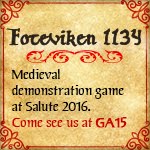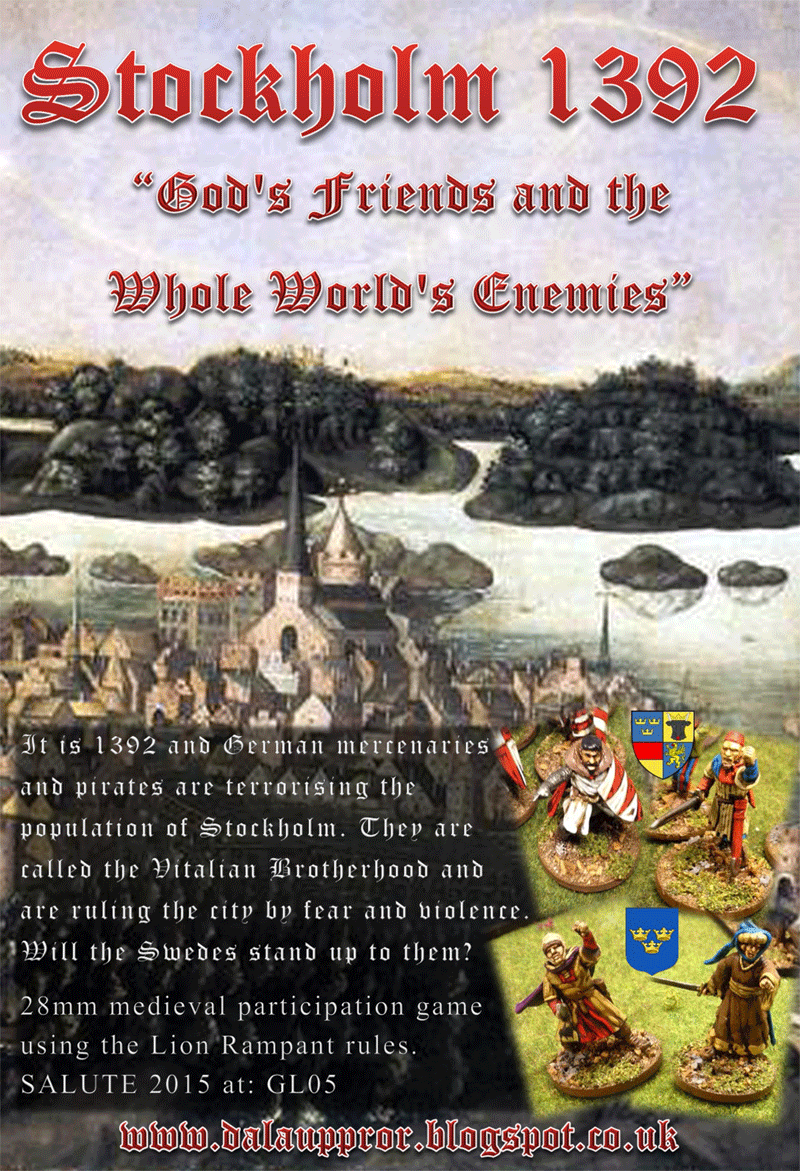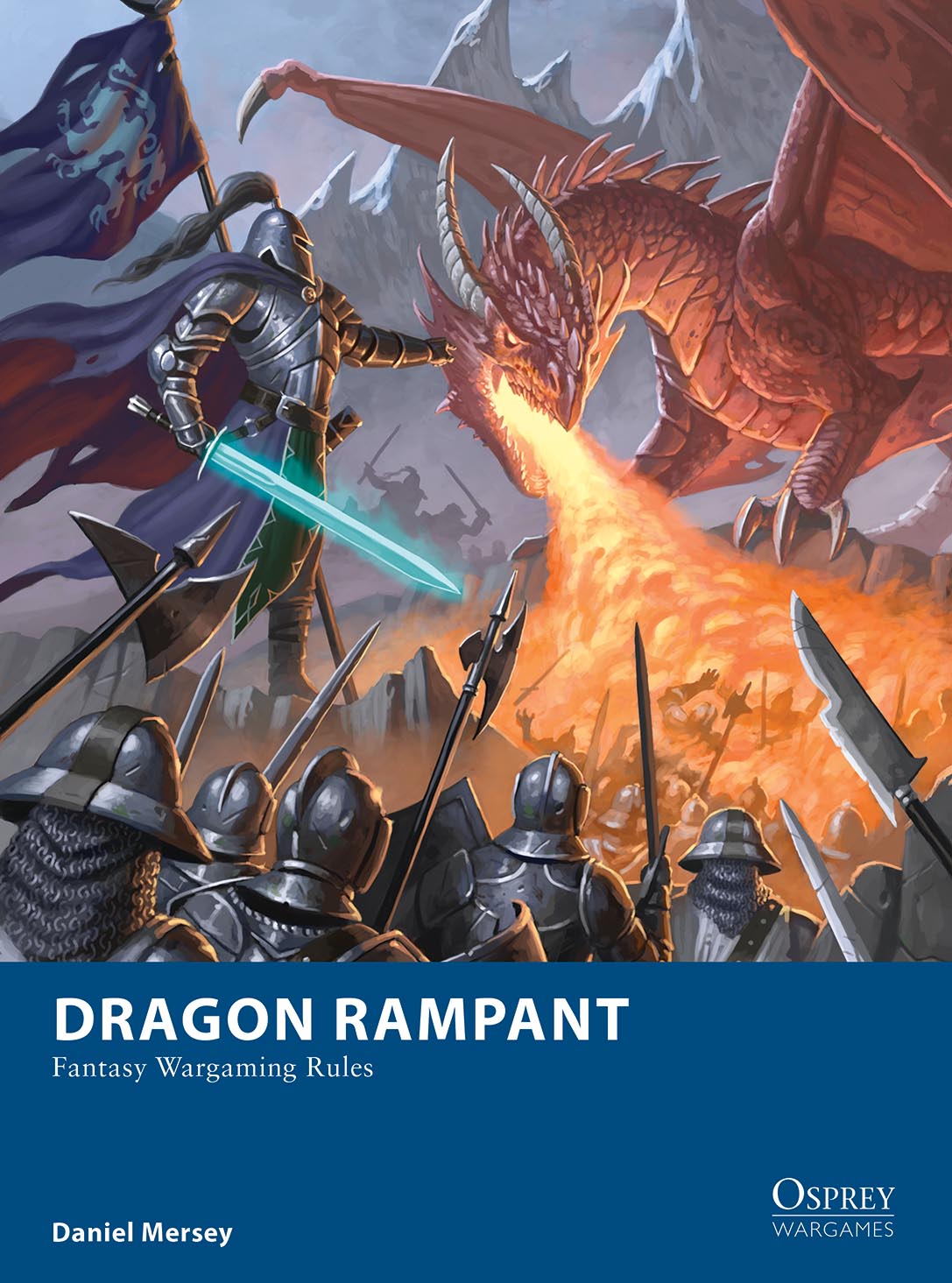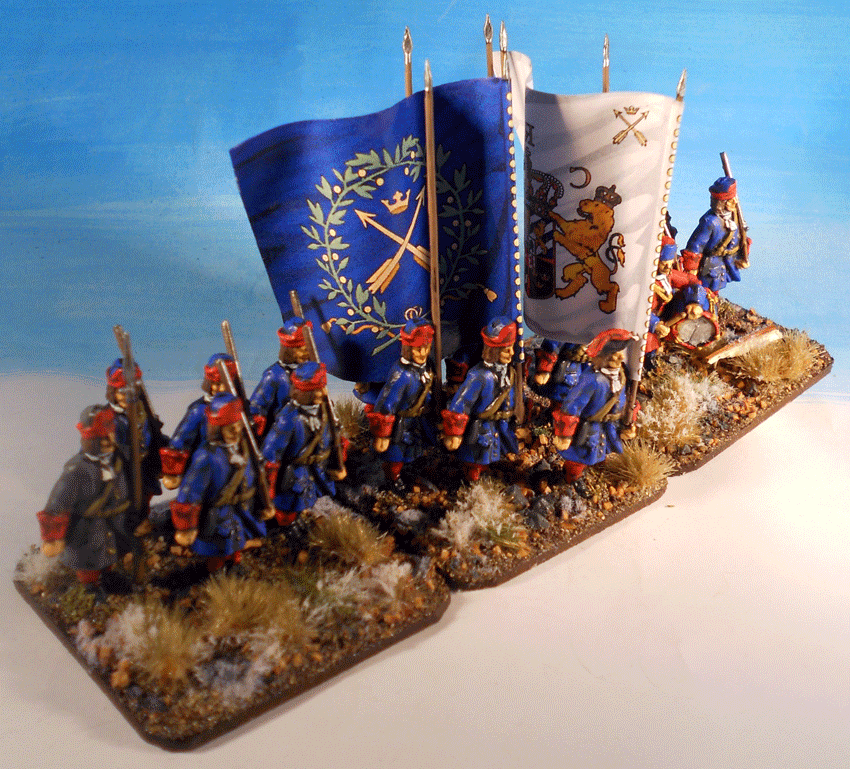Minis from Wargames Factory WSS Plastic infantry and the Flags are from Warfare Miniatures GNW range, so they arn´t realy right but close enought.
Dalregementet (Dalarna Regiment, Darlecarlian Regiment), Modern designations I 13 (13th Infantry Regiment), was a Swedish Army infantry regiment that traced its origins back to the 16th century. It was disbanded in 2000. The regiment's soldiers were originally recruited from the province of Dalarna, and it was later garrisoned there.
The regiment has its origins in fänikor (companies) raised in Dalarna in 1542. During 1598, some of the units participated in the War against Sigismund and in 1605 one fänika from Dalarna fought at the Battle of Kircholm. In 1615, these units—along with fänikor from the nearby provinces of Uppland and Västmanland—were organised by Gustav II Adolf into Upplands storregemente, of which 1,400 of the total 3,000 soldiers were recruited in Dalarna. Upplands storregemente consisted of three field regiments, of which Dalregementet was one.
Dalregementet was also the first Swedish regiment to be allotted, which happened as early as in 1621. Parts of this grand regiment participated in the Polish–Swedish wars during the siege of Riga in 1621 and as garrison from 1626–1629. During this period, sometime between 1623 and 1628, the grand regiment was permanently split into three smaller regiments, of which Dalregementet was one. The regiment's first commander was Axel Oxenstierna.
The regiment returned to Sweden to replenish shortly after and remained at home until 1638, when one of the regiment's two battalions was sent as garrison to Stettin. Dalregementet was one of the original 20 Swedish infantry regiments mentioned in the Swedish constitution of 1634. Carl Gustaf Wrangel was the commander from 1639 on. The second battalion was sent to Germany in 1642, and the whole regiment fought at the Battle of Leipzig that year, only to return to Sweden again the following year. They were present during the siege of Landskrona in 1644 during the short Torstenson War.
It then was subordinated to the main army that fought at Holovczyn, Malatitze and finally at the Battle of Poltava, where the regiment surrendered to the Russians. The regiment was reformed with new recruits in Sweden in 1710 and was sent to Pomerania and the Battle of Gadebusch in 1712. Dalregementet once again had to surrender, this time in 1713 after the Battle of Tönningen. The regiment was reformed a second time, and took part in both the 1716 and 1718 attacks on Norway.
- The War against Sigismund (1598–1599)
- The Polish War (1600–1629)
- The Thirty Years' War (1630–1648)
- The Torstenson War (1643–1645)
- The Northern Wars (1655–1661)
- The Scanian War (1674–1679)
- The Great Northern War (1700–1721)
- The Hats' Russian War (1741–1743)
- The Seven Years' War (1757–1762)
- The Gustav III's Russian War (1788–1790)
- The First War against Napoleon (1805–1810)
- The Campaign against Norway (1814)
Organisation 1634(?)
1200 men in 2 Batallions of 4 Companys each
- Livkompaniet
- Överstelöjtnantens kompani
- Majorens kompani
- Orsa kompani
- Rättviks kompani
- Gagnef kompani
- Mora kompani
- Västerdals kompani






























They look terrific Michael; I love the basing.
ReplyDeleteSplendid work Michael! Very impressing.
ReplyDeleteVery very nice indeed, love the bases and the advancing massed formation feeling you've achieved here! Great to have a read on this famous regiment's history as well.
ReplyDeleteI hope you to still painting for your Lund 1676 project....
DeleteThanks for the historical overview which was fascinating:).
ReplyDeleteThey look stunning Michael and matched by the amazing groundwork!
ReplyDeleteWonderful looking unit and great write up too!
ReplyDeleteExcellent Michael!!! I love the look of the unit with the command massed in the center!!
ReplyDeleteExcellent post, love these beautiful units!
ReplyDeleteThey look great; and plastics too! Just amazingly good!
ReplyDeleteThose look very nice Michael!
ReplyDeleteChristopher
They look great!!! :D
ReplyDeleteVery nice indeed mate. I'd heard mixed reports of the quality of these figs. You've certainly made them pop!
ReplyDeleteDamn fine painting and basing. The flags are icing on the cake!
ReplyDeleteThanks for sharing this units long and fascinating history.
Stunning looking unit Michael! i love the flags
ReplyDeleteAppreciated mateys !
ReplyDeleteThe minis wasn't that bad with some cuting in the necks of the heads, so the wouldent look like giraffes...
Good that plastic are easy to work with:)
Very informative post and awesome looking troops Michael. Love the basing too!
ReplyDeleteThank you Rodger !
DeleteI´m glad that several mentioned the bases, As the Battle at Lund was 4 december 1676 the first snow had come and it was a very cold night before the battle. So Sören have decided to base all his minis with a mud/snow /dead gras mix and I thought it looked really good and also wanted mine bases to mix the ones Sören have made.
Best regards Michael
Great painting work!!! And very interesting the additional information. Thank you a lot.
ReplyDeleteExcellent painting and basing.
ReplyDeleteNice go see. It's My regimens, sida my service at Livkompagniet 1974-74 as antitankplatoonleader , now I reenact Carolean from 18th Century blue and yellow uniform and tricorne. 😁 //Erik
ReplyDelete